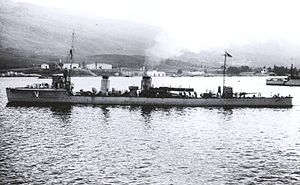Japanese destroyer Kashi (1916)
 A Momo class destroyer, possibly Kashi
| |
| History | |
|---|---|
| Name | Kashi |
| Namesake | Evergreen Oak Tree in Japanese |
| Builder | Maizuru Naval Arsenal, Japan |
| Laid down | 15 March 1916 |
| Launched | 1 December 1916 |
| Fate | Transferred to Manchukuo Imperial Navy |
| History | |
| Name | Han Wei |
| Acquired | 1 May 1937 |
| Fate | Transferred back to Japan |
| History | |
| Name | Kali |
| Acquired | 6 June 1942 |
| Fate | Sunk on 10 October 1944 by the Fast Carrier Task Force |
| General characteristics | |
| Class and type | Momo-class destroyer |
| Type | Destroyer |
| Displacement |
|
| Length |
|
| Beam | 7.7 m (25 ft) |
| Draught | 2.3 m (7.5 ft) |
| Propulsion | 2-shaft steam turbine, 4 heavy oil-fired boilers 16,700 ihp (12,500 kW) |
| Speed | 31.5 knots (58.3 km/h) |
| Range | 2,400 nautical miles (4,400 km) at 15 knots (28 km/h) |
| Complement | 110 |
| Armament |
|
The Kashi was a Japanese destroyer of the Momo-class, built in Japan, that served in the last part of World War One, and throughout World War Two, as part of the Imperial Japanese Navy, and the Imperial Manchukuo Navy, before being returned to the Imperial Japanese Navy.[1]
History
Japan
The Kashi along with the other three destroyers in the Momo class, served in Malta from August 1917 to the end of World War One in November 11, 1918. They were attached to the 15th Flotilla along with the cruiser Idzumo, assigned to protect convoys.[2]
Manchukuo
Kashi was transferred to the Manchukuo Imperial Navy on 1 May 1937 and was renamed Hai Wei (Chinese: 海威; pinyin: Hǎi Wēi).[1]
Japan again
On 6 June 1942, Hai Wei was transferred back to the Imperial Japanese Navy, and reclassified as the auxiliary escort Kaii. The ship fought in World War II, and was sunk by United States Navy aircraft from the Fast Carrier Task Force off of Okinawa on 10 October 1944.[1]
References
- ^ a b c "Japanese Destroyers". www.battleships-cruisers.co.uk. Retrieved 9 December 2016.
- ^ "Japanese Navy, IJN, World War 1". www.naval-history.net. Retrieved 9 December 2016.
